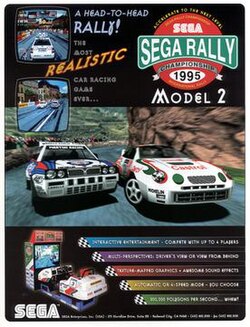Sega Rally Championship: Difference between revisions
m some serious overlinking going on here |
dubious, see talk page |
||
| Line 24: | Line 24: | ||
'''''Sega Rally Championship''''' is a 1994 [[arcade game|arcade]] [[Racing video game|racing game]] developed by [[Sega Rosso|AM5]]<ref>[http://www.system16.com/sega_developers.php#am5 Sega Arcade Developers]</ref> on the [[Sega Model 2]] board. It was a year later in 1995 ported over to the [[Sega Saturn]] (by [[Sega AM3|AM3]]) and [[IBM PC compatible|PC]]. |
'''''Sega Rally Championship''''' is a 1994 [[arcade game|arcade]] [[Racing video game|racing game]] developed by [[Sega Rosso|AM5]]<ref>[http://www.system16.com/sega_developers.php#am5 Sega Arcade Developers]</ref> on the [[Sega Model 2]] board. It was a year later in 1995 ported over to the [[Sega Saturn]] (by [[Sega AM3|AM3]]) and [[IBM PC compatible|PC]]. |
||
The [[unique selling point]] of ''Sega Rally'' was the ability to drive on different surfaces (including asphalt, gravel and mud), with different friction properties, with the car's handling changing accordingly. As the first racing game to incorporate this feature, ''Sega Rally'' is considered to be one of the milestones in the evolution of the racing game genre.<ref>''Guinness World Records: Gamer's Edition 2009'', page 103</ref> It was also an early [[Rallying|rally]] racing game and featured [[cooperative gameplay]] alongside the usual competitive multiplayer. |
The [[unique selling point]] of ''Sega Rally'' was the ability to drive on different surfaces (including asphalt, gravel and mud), with different friction properties, with the car's handling changing accordingly. As the first racing game to incorporate this feature{{dubious|date=October 2013}}, ''Sega Rally'' is considered to be one of the milestones in the evolution of the racing game genre.<ref>''Guinness World Records: Gamer's Edition 2009'', page 103</ref> It was also an early [[Rallying|rally]] racing game and featured [[cooperative gameplay]] alongside the usual competitive multiplayer. |
||
The music for the arcade game was composed by [[Takenobu Mitsuyoshi]], while the Sega Saturn port's soundtrack was done by [[Naofumi Hataya]] and performed by [[Joe Satriani]]. |
The music for the arcade game was composed by [[Takenobu Mitsuyoshi]], while the Sega Saturn port's soundtrack was done by [[Naofumi Hataya]] and performed by [[Joe Satriani]]. |
||
Revision as of 03:36, 28 October 2013
| Sega Rally Championship | |
|---|---|
 | |
| Developer(s) | AM5 AM3 (Saturn port) United Game Artists (PlayStation 2 port) |
| Publisher(s) | Sega |
| Designer(s) | Tetsuya Mizuguchi |
| Composer(s) | Takenobu Mitsuyoshi (Arcade version) Naofumi Hataya (Saturn version) |
| Platform(s) | Arcade, Sega Saturn, PC, N-Gage, Game Boy Advance, PlayStation 2 |
| Release | October 1994 |
| Genre(s) | Racing game |
| Mode(s) | Single-player, multiplayer |
| Arcade system | Sega Model 2 |
Sega Rally Championship is a 1994 arcade racing game developed by AM5[1] on the Sega Model 2 board. It was a year later in 1995 ported over to the Sega Saturn (by AM3) and PC. The unique selling point of Sega Rally was the ability to drive on different surfaces (including asphalt, gravel and mud), with different friction properties, with the car's handling changing accordingly. As the first racing game to incorporate this feature[dubious – discuss], Sega Rally is considered to be one of the milestones in the evolution of the racing game genre.[2] It was also an early rally racing game and featured cooperative gameplay alongside the usual competitive multiplayer.
The music for the arcade game was composed by Takenobu Mitsuyoshi, while the Sega Saturn port's soundtrack was done by Naofumi Hataya and performed by Joe Satriani.
Gameplay
The player can enter a "World Championship" mode consisting of three stages: Desert (which resembles African savanna), Forest (which resembles South American forests) and Mountain (which partly resembles Monaco and Corsica), where their finishing position at the end of one course is carried through to the starting position of the next course. In this mode, it is impossible to reach first place position by the end of the first track; thus, the player must try to overtake as many opponent cars as possible on each track (while staying within the time limit), and gain the lead over several tracks. If, at the end of the third round, the player is in first place, they are able to play a fourth secret circuit called "Lakeside" (on the Saturn version, this course may then be played in time attack and split-screen multiplayer modes).
Three cars are featured in the game; Didier Auriol's sixth generation Toyota Celica and Juha Kankkunen's Lancia Delta HF Integrale which are both available from the start, and Sandro Munari's Lancia Stratos HF which can be unlocked.
Cars
- Toyota Celica GT-Four ST205
- Lancia Delta HF Integrale
- Lancia Stratos HF (Unlockable on home ports only)
Reception
It was named the best racing game of all time by Retro Gamer magazine, which ranked it at the top of its "Top 25 Racing Games Ever" list.[3] Codemasters have cited Sega Rally as a strong influence on their first Colin McRae Rally game.[citation needed] In Guinness World Records: Gamer's Edition 2009 the Saturn version of the game made it to 44th position in the list of the Top 50 Console Games, due to its "distinct handling style and superb track design."[citation needed] IGN staff writer Levi Buchanan ranked Sega Rally Championship 6th in his list of the top 10 Sega Saturn games, saying "Yes, the Dreamcast version is much better and the current-gen sequel... is stunning, but this Saturn arcade port was one of the top reasons to stick by SEGA as it flailed through the 32-bit days."[4]
References
- ^ Sega Arcade Developers
- ^ Guinness World Records: Gamer's Edition 2009, page 103
- ^ "Top 25 Racing Games... Ever! Part 2". Retro Gamer. 21 September 2009. pp. 5–6. Retrieved 2011-03-17.
- ^ Buchanan, Levi (2008-07-29). "Top 10 SEGA Saturn Games". IGN. Retrieved 2013-04-03.
